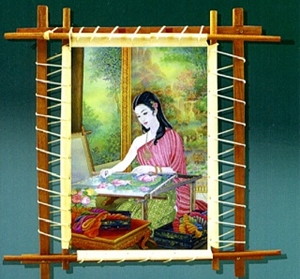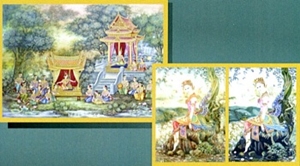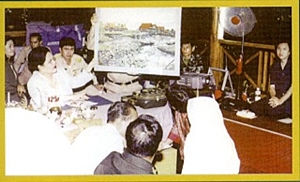Queen’s Gallery at the head of Ratchadamnoen Road at the Thai capital’s historic Phan Fah intersection is splashing brilliantly-coloured embroidery by local artisans from Aug 2 through Nov 13.
The works on display were created by artisans whose first opportunities for training to do sophisticated art was under the support of Her Majesty Queen Sirikit, a patron of Thai culture and art. The queen admires and is proud of the nation’s heritage.

She believes that the Thai people have talent in artistic skills, handed down from their ancestors. Although they have never formally studied it, due to their native talent they will be able to develop their skill to create aesthetic works in a short while after being well-trained.
The queen was inspired to preserve Thai-style embroidery when she found an elegantly embroidered picture of the Suphannahongsa Royal Barge in the Grand Palace. Its painting-like meticulous pattern caught the royal patron’s attention and remained in mind.
Learning that it was the artwork of a royal artisan in the reign of King Rama V, His Majesty King Chulalongkorn, and that the technique had been passed down through generations of court artisans, she directed a royal master to teach a new generation of palace officials to learn the skill.
In 1975, Their Majesties the King and Queen stayed at the Thaksin Ratchaniwet Palace in the southern province of Narathiwat while visiting their subjects. Seeing the life of local people, the queen learned that after tapping para rubber, the main income earning job of most southerners, early in the morning, rubber growers had plenty of time left during the day.

The queen’s sponsorship means that villagers undergo varied local folk handicraft training as a supplementary skilled occupation increase their income such as weaving Yan Lipao (vine fern) and Krajood (straw reed) to create various products.
Noticing Muslim women wearing detailed embroidered hijabs, or headscarves, the queen provided them training to try easy patterns with the special technique and bought their finished work to encourage them to continue practicing their skills.
Once their skills had been developed, they shifted from using normal thread to silk thread and the simple floral patterns were replaced by real paintings.
To help embroidery artisans produce thread in colours close to the hues of the paintings, a silk dying technique was taught to them, so they could create up to hundred hues to make their embroidery look like the real paintings.

In 2001, the Queen established the Foundation for the Promotion of Supplementary Occupations’ new section to create model paintings for embroidery in the compound of Chitralada Palace.
Artists who realise the value of Thai culture and have knowledge in Thai history, religion and literature were selected to work.
She herself selected the paintings and explained the story of each painting to foundation members to inspire them.
The artisans were proud of their craftsmanship as the Queen herself reviewed their finished work, praising and rewarding them.
Each piece of embroidery is not only valuable art, but it also reflects love, faith, pride and the deep bond between the Queen and her subject.
The embroidery project was expanded to other provinces. Currently, there are up to 10,000 members, most now with better living, debt free, and with the ability to support their children’s education.
From August through mid-November the Queen’s Gallery at 101 Ratchadamnoen Klang Road, the exhibition offers embroidery for sale, basic embroidery training is on offer and cultural shows will be performed on Sundays. For more information, please contact the gallery at 02-2815360-1 or view its website at http://www.queengallery.org/.




